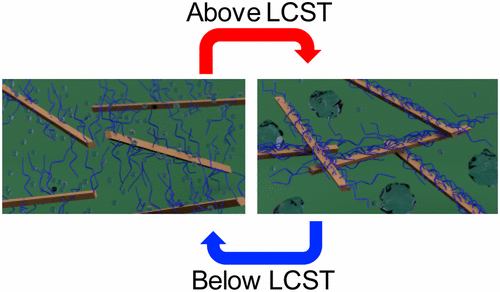当前位置:
X-MOL 学术
›
ACS Cent. Sci.
›
论文详情
Our official English website, www.x-mol.net, welcomes your
feedback! (Note: you will need to create a separate account there.)
Biomimetic Reversible Heat-Stiffening Polymer Nanocomposites
ACS Central Science ( IF 12.7 ) Pub Date : 2017-07-26 00:00:00 , DOI: 10.1021/acscentsci.7b00215 Elvis Cudjoe 1 , Shaghayegh Khani 1 , Amanda E. Way 1 , Michael J. A. Hore 1 , Joao Maia 1 , Stuart J. Rowan 1, 2, 3
ACS Central Science ( IF 12.7 ) Pub Date : 2017-07-26 00:00:00 , DOI: 10.1021/acscentsci.7b00215 Elvis Cudjoe 1 , Shaghayegh Khani 1 , Amanda E. Way 1 , Michael J. A. Hore 1 , Joao Maia 1 , Stuart J. Rowan 1, 2, 3
Affiliation

|
Inspired by the ability of the sea cucumber to (reversibly) increase the stiffness of its dermis upon exposure to a stimulus, we herein report a stimuli-responsive nanocomposite that can reversibly increase its stiffness upon exposure to warm water. Nanocomposites composed of cellulose nanocrystals (CNCs) that are grafted with a lower critical solution temperature (LCST) polymer embedded within a poly(vinyl acetate) (PVAc) matrix show a dramatic increase in modulus, for example, from 1 to 350 MPa upon exposure to warm water, the hypothesis being that grafting the polymers from the CNCs disrupts the interactions between the nanofibers and minimizes the mechanical reinforcement of the film. However, exposure to water above the LCST leads to the collapse of the polymer chains and subsequent stiffening of the nanocomposite as a result of the enhanced CNC interactions. Backing up this hypothesis are energy conserving dissipative particle dynamics (EDPD) simulations which show that the attractive interactions between CNCs are switched on upon the temperature-induced collapse of the grafted polymer chains, resulting in the formation of a percolating reinforcing network.
中文翻译:

仿生可逆热强化聚合物纳米复合材料
受海参在受到刺激后能够(可逆地)增加其真皮硬度的能力的启发,我们在此报告了一种刺激响应性纳米复合材料,该纳米复合物在暴露于温水后可以可逆地提高其硬度。由纤维素纳米晶体(CNC)组成的纳米复合材料接枝了嵌入在醋酸乙烯酯(PVAc)基质中的较低临界溶液温度(LCST)聚合物,在暴露时模量显着增加,例如从1 MPa增大到350 MPa对于温水来说,假说是从CNC中接枝聚合物会破坏纳米纤维之间的相互作用,并使薄膜的机械增强作用最小化。然而,由于增强的CNC相互作用,暴露于LCST上方的水中会导致聚合物链塌陷,并随后使纳米复合材料变硬。支持该假设的是节能的耗散粒子动力学(EDPD)模拟,该模拟显示,在温度诱导的接枝聚合物链塌陷时,CNC之间的有吸引力的相互作用就会打开,从而导致渗流增强网络的形成。
更新日期:2017-08-23
中文翻译:

仿生可逆热强化聚合物纳米复合材料
受海参在受到刺激后能够(可逆地)增加其真皮硬度的能力的启发,我们在此报告了一种刺激响应性纳米复合材料,该纳米复合物在暴露于温水后可以可逆地提高其硬度。由纤维素纳米晶体(CNC)组成的纳米复合材料接枝了嵌入在醋酸乙烯酯(PVAc)基质中的较低临界溶液温度(LCST)聚合物,在暴露时模量显着增加,例如从1 MPa增大到350 MPa对于温水来说,假说是从CNC中接枝聚合物会破坏纳米纤维之间的相互作用,并使薄膜的机械增强作用最小化。然而,由于增强的CNC相互作用,暴露于LCST上方的水中会导致聚合物链塌陷,并随后使纳米复合材料变硬。支持该假设的是节能的耗散粒子动力学(EDPD)模拟,该模拟显示,在温度诱导的接枝聚合物链塌陷时,CNC之间的有吸引力的相互作用就会打开,从而导致渗流增强网络的形成。











































 京公网安备 11010802027423号
京公网安备 11010802027423号